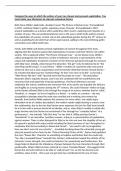Compare the ways in which the writers of your two chosen texts present exploitation. You
must relate your discussion to relevant contextual factors
Both Oscar Wilde’s ekphrastic, decadent novel ‘The Picture of Dorian Gray’, first published
in 1891, and Bram Stoker’s gothic, epistolary novel, ‘Dracula’, first published in 1897,
present exploitation as a theme which underlines their novel’s, exploring such injustice in a
number of ways. This can predominately be seen in the way in which both authors present
the exploitation of women, in their role as the subordinate gender during the 19 th century as
well as exploiting fin de siècle fears of the supernatural, adding to the overwhelming gothic
convention seen within both texts.
Firstly, both Wilde and Stoker present exploitation of women throughout their texts,
aligning with the Victorian patriarchal expectations of women and their inferior role within
society. This is explored within ‘The Picture of Dorian Gray’ - we see Dorian Gray, Wilde’s
callous protagonist who becomes a victim to hedonism, become a representation of the
unjust and exploitative treatment of women in the Victorian patriarchy through his romance
with Sibyl Vane. Initially, when Dorian first describes “the girl” (who he believed to be “the
only thing worth loving”), to Lord Henry – Wilde’s creation of a perfectly witty and cynical
aristocrat who was a close acquaintance and immensely influential mentor toward Dorian –
he remarks that Sibyl was the “loveliest thing” he had “ever seen in his life” as she had a
“little flower-like face” with “lips that were like the petals of a rose”. This description
illustrates Sibyl’s exquisite beauty, and it was this combined with her youthfulness and
innocence that enchanted the Victorian gentleman. The floral references not only
emphasise the actress’ prettiness but moreover hint at her purity and arguably her delicacy
and fragility as a young woman during the 19th century. She could ‘blossom’ whilst on stage,
as the theatre allowed Sibyl to live through the visage of an actress, whether that be ‘Juliet’,
‘Rosalind’, or ‘Imogen’ yet in her fragility as a flower – or rather as a woman – she was
susceptible to damage when the mask was unveiled and a working class woman lay
beneath. Even before Wilde explores this romance (or more rather, one might argue
infatuation to be of a better description), the modern reader might develop a concern over
this relationship, due to the fact that Dorian never expresses his love for Sibyl Vane herself.
He is in love with a woman devoid of an identity, and so, when Sibyl is unable to satisfy this
tragic heroine role that Dorian has envisioned of her through her “complete failure” of a
performance”, she instantly “kills (his) love” for her with it. Wilde portrays Dorian’s
“heartbreak” in an insensitive, heartless manner, acting as a representation of exploitation
against women. There is utter disregard for Sibyl as he cries out over the stupidity of her act.
His speech is packed with unjust words including the direct pronoun of ‘you’ throughout to
emphasise that she has nobody to blame but herself – “you used to stir my imagination.
Now you don’t even stir my curiosity”, – inevitably breaking down the vulnerable young girl
who just poured out her heart to her “Prince Charming! Prince of life”. Dorian had exploited
the once “flower-like” character to something so helpless and broken that she could only
“lay…like a trampled flower” beneath him. Dorian’s mistreatment wiped the entirety of the
character’s inner strength, she could not help but ‘lay’ powerlessly and furthermore, this
image helps to illustrate the imbalance of power between the two characters through their
positionality. Where Sibyl has been referred to a mere ‘trampled flower’, this suggests that
Dorian has and will continue to be able to ‘walk all over’ her, as she has become such
worthless value to him – this is just one girl who has contributed to the one of many




